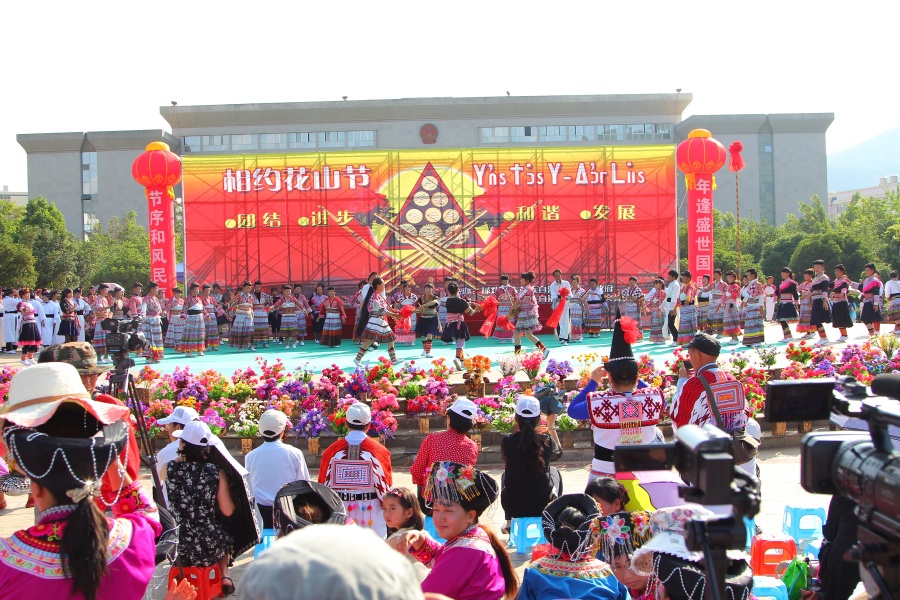Pu Neng – Inheritor of “Yanglaogu Dance” in Lufeng County, Chuxiong
楚雄州禄丰县腰站乡“羊老鼓舞”传承人 – 普能
http://www.ynich.cn/view-ml-13111-2939.html
Yang Shiming – Inheritor of Miao Musical Instrument -playing Skill in Lufeng County, Chuxoing
楚雄州禄丰县腰站乡苗族乐器演奏技艺传承人 – 杨世明
http://www.ynich.cn/view-ml-13111-2834.html
E Jiashou – Shadow Play Artist in Lufeng County, Chuxiong
禄丰县川街乡皮影艺人 – 额家寿
http://www.ynich.cn/view-ml-13111-2696.html
Xiao Guoqing – Inheritor of Stone Lion-carving Craft in Lufeng County, Chuxiong
禄丰县黑井镇石狮雕刻传承人 – 肖国庆
http://www.ynich.cn/view-ml-13111-2614.html
Feng Yulin – Master of Folk Buddha Sculpture in Lufeng County, Chuxiong
禄丰县民间佛像雕塑艺人 – 冯玉林
http://www.ynich.cn/view-ml-13111-2551.html
Overview of Introducion
Chinese Name: 禄丰县苗族花山节
English Name: Huashan Festival of Miao Ethnic Minority in Lufeng County, Chuxiong
Location: Hongtushan Village of Qinfeng Town in Lufeng County/禄丰勤丰镇红土山村
The Flower Mountain Festival is a cherished tradition among the Miao ethnic group, celebrated by Miao communities in central Yunnan Province on the fifth day of the fifth lunar month, which aligns with the Duanwu Festival. This festival boasts a profound historical legacy. Legend has it that during ancient times in China’s tribal era, conflicts among tribes led to the defeat of the Miao chieftain. Faced with adversity, the Miao people were forced to leave their homes and wander, becoming separated from their families. In a bid to reunite, they selected a lofty mountain where they erected a flower pole adorned with red silk atop its summit. Gathering around this pole, they played lusheng—a traditional wind instrument—and performed lusheng dances, expressing both sorrow and joy.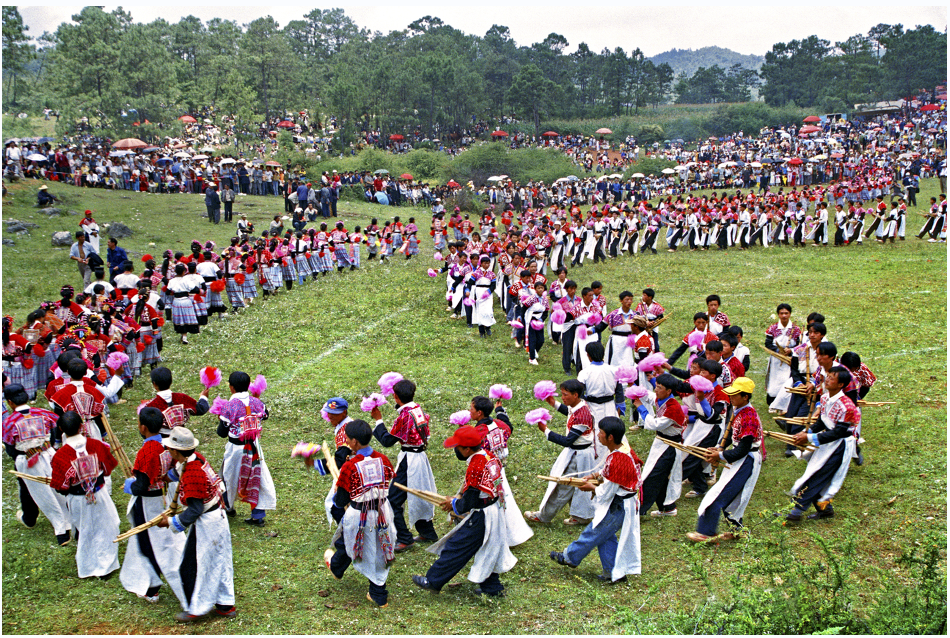
More Details
Word of the flower pole and the sound of the lusheng reached dispersed relatives, prompting them to spread the news far and wide. Soon, people from all directions flocked to the site, resulting in a joyous reunion of long-lost kin. Hence, every fifth day of the fifth lunar month, the Miao people erect a flower pole on an open highland, gathering to play lusheng and dance lusheng dances. This annual tradition has solidified into the Flower Mountain Festival of the Miao ethnic group.
The Flower Mountain Festival carries deep cultural significance, symbolizing themes of reunion, unity, and communal gatherings. It serves as a poignant celebration of familial reunions and mutual blessings, embodying the unity, harmony, and aspirations for a better life that resonate across generations of Miao people.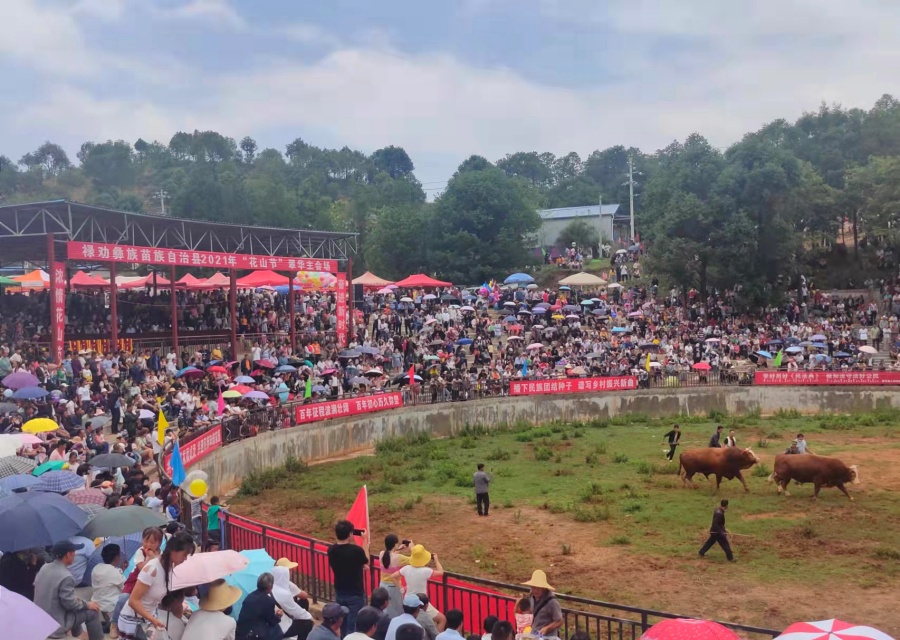
Hosted by: Cuihua Town, Lufeng County. Event Date: June 14, 2021. Event Theme: 2021 Flower Mountain Festival.
Bullfighting stands out as one of the liveliest activities during the Miao Flower Mountain Festival, attracting participants from diverse ethnic backgrounds who gather together to cheer and revel in the excitement.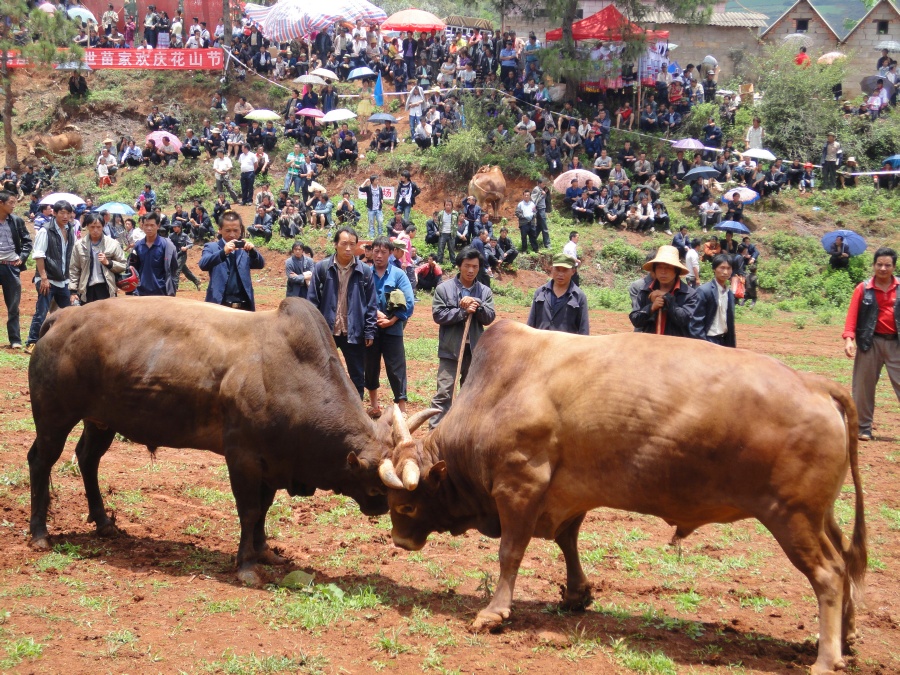
The Miao Flower Mountain Festival in Lufeng County is an annual event held on the fifth day of the fifth lunar month, coinciding with the Duanwu Festival. Festivities include bullfighting, flower pole worship, lusheng dancing, flower pole climbing, cockfighting, crossbow shooting, and more. In recent years, with its grand scale and vibrant atmosphere, the Flower Mountain Festival has emerged as a splendid emblem of ethnic cultural tourism in Lufeng County.
http://www.kmlq.gov.cn/c/2022-02-16/5796763.shtml
ChuGuang Expressway from Chuxiong to Guangtong楚广高速公路(楚雄-禄丰县广通镇), Chuguang Expressway (楚广高速公路) is an important expressway in Yunnan Province, China, connecting Chuxiong City to Guangtong County. Here’s an overview of this expressway:
Why is the Grand Courtyard of Wu Family So Special
The Wu Family was the first large salt merchant in Heijing Ancient Town in the Qing Dynasty. In that year, it was the richest man in Heijing. The Grand Courtyard of Wu Family is a typical Ming and Qing architecture that has been preserved to now. The Grand Courtyard of Wu Family was built in the 16th year of Daoguang in Qing Dynasty. It was expended in the 7th year of Xianfeng in Qing Dynasty and was built along the mountain. It is a “王(Wang)-shape”, with a unique layout. It consists of four patios with 99 houses and 108 doors. It, with a building area of 10,000 square meters, is well-connected and is one of the rare ancient residential buildings in Yunnan. Standing on the third floor of the Grand Courtyard of Wu Family, you can overlook the entire view of Heijing Ancient Town.
Where is the Grand Courtyard of Wu Family
It is located at Heijing Ancient Town, Lufeng County, Chuxiong Yi Autonomous Prefecture.
How to Get There
- In Chuxiong Passenger Station, there are buses to Heijiang Town.
- It is very convenient to Heijing Station by train from Kunming Railway Station.
- After arriving in Lufeng County, car rental or self-driving is the recommended way to get to Heijing Ancient Town.
Introduction of the Grand Courtyard of Wu Family
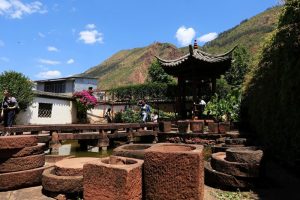
The Wu Family Courtyard was the richest man in Heijing Town during the Republic of China. When he moved from Nanjing, Mr. Wu was the largest salt merchant in the local area.
At present, all rooms in the Grand Courtyard of Wu Family have been converted into hotel for accommodation, and the front yard has been converted into a tea room with a quiet environment. It is a great thing in life to drink tea and play chess here with once pavilions, carved beams. Time is like a filter, filtering out the dust-laden memory, and the Grand Courtyard of Wu Family is like this. In January 2012, the Grand Courtyard of Wu Family was announced as a key cultural relics protection unit in Yunnan Province.
Best Time to Go
The Heijing Ancient Town is suitable for tourism all year round. The area belongs to the subtropical monsoon climate, with warm spring and heavy drought, no summer heat, cool autumn, no cold in winter, small annual temperature difference, large daily temperature difference, and obvious dry and wet seasons. The annual rainy season is from May to October, and the annual average temperature is 15-21 °C.
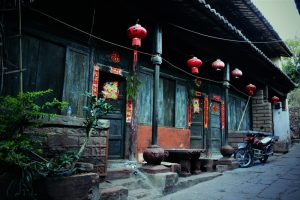
Nearby Attractions
Feilaisi Temple
Feilaisi Temple is located at the hillside. Because of the steep mountain, looking from the bottom of the mountain, the whole temple is like a big bird entwined in the mountain. It seems to be flying and it also seems to have just landed from the sky. Therefore, Feilaisi Temple got its name. Looking down from the temple, the Longchuanjiang River(龙川江) passes through the deep canyon, and the town’s buildings are dotted on both sides of the river.
Heijing Confucius Temple
The Heijing Confucian Temple is located in the Longchuanjiang River Gorge(龙川江峡谷), Lufeng County, Chuxiong Prefecture. The Heijing Confucius Temple was built in the 45th year of Ming Wanli (1617). It was repeatedly destroyed by mudslides in the Qing Dynasty and was repeatedly rebuilt. The Confucius Temple is large in scale. There were 13 scholars (进士), which could show the prosperity of Heijing culture education.
Why is Lianxiangguan Ancient Village So Special
Lianxiangguan Ancient Village, known as the gathering place of salt merchants, has a long history, characterized by multi-culture. It thrived and declined due to the salt. Lianxiangguan has remained the relatively complete traditional urban pattern, which generated unique and profound culture and blended into the inclusive ancient architectural culture. Ancient dwellings, religions, memorial archways, pavilions, and styles remain as before, with a clear historical and culture context and distinctive features. It preserves precious cultural heritage, such as temples, squares, houses, ancient carvings, wood carvings, ethnic culture, and food culture. It is based on the unique geographical environment and the traditional architecture of the traditional style. The combination of humanistic environment has become the unique museum of ancient architecture and culture in Yunnan. The tourism resources of Lianxiangguan are centered on ancient buildings, with the ancient village market as the carrier, combining with humanity, natural landscape, unique connotation, obvious features. Meanwhile, Lianxiangguan Ancient Village has the ornamental, recreational and use value. In February 2002, it was named as a provincial-level historical and cultural village by the provincial people’s government.
Where is Lianxiangguan Ancient Village
Lianxiangguan (炼象关) Ancient Village is located in the Lianxiangguan Village Committee, Jinshan Town, Lufeng County, 80 kilometers away from Kunming, 86 kilometers away from Chuxiong and 18 kilometers away from Lufeng County. It is the main thoroughfare to the western Yunnan, also the intersection of Dianchi Culture and Erhai Culture.
How to Get There
It is 18 kilometers from downtown of Lufeng County. It is convenient to get to Lianxiangguan Ancient Village. Taxi or self-driving is the best way to get there.
Best Time to Go
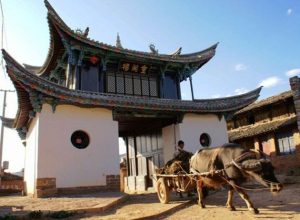
It is suitable to visit Lianxiangguan Ancient Village at any time. Every season, visitors can experience the unique culture and rich folk customs.
Nearby Attractions
The Grand Courtyard of Wu Family
The Grand Courtyard of Wu Family is a typical Ming and Qing architecture that has been preserved to now. The Grand Courtyard of Wu Family was built in the 16th year of Daoguang in Qing Dynasty. It was expended in the 7th year of Xianfeng in Qing Dynasty and was built along the mountain. It is a “王(Wang)-shape”, with a unique layout. It consists of four patios with 99 houses. It, with a building area of 10,000 square meters, is well-connected and is one of the rare ancient residential buildings in Yunnan.
Feilaisi Temple
Feilaisi Temple is located at the hillside. Because of the steep mountain, looking from the bottom of the mountain, the whole temple is like a big bird entwined in the mountain. It seems to be flying and it also seems to have just landed from the sky. Therefore, Feilaisi Temple got its name. Looking down from the temple, the Longchuanjiang River(龙川江) passes through the deep canyon, and the town’s buildings are dotted on both sides of the river.
Heijing Confucius Temple
The Heijing Confucian Temple is located in the Longchuanjiang River Gorge(龙川江峡谷), Lufeng County, Chuxiong Prefecture. The Heijing Confucius Temple was built in the 45th year of Ming Wanli (1617). It was repeatedly destroyed by mudslides in the Qing Dynasty and was repeatedly rebuilt. The Confucius Temple is large in scale. There were 13 scholars (进士), which could show the prosperity of Heijing culture education.
Heijing Ancient Town
With traditional folk residences, archways, and religion architectures, Heijing Ancient Town is well conserved in a traditional style as others do in China. Among them, 27 have been listed as county-level cultural relics protection units, and are known as “the treasure house of historical relics – the living fossil of Ming and Qing Dynasties”.

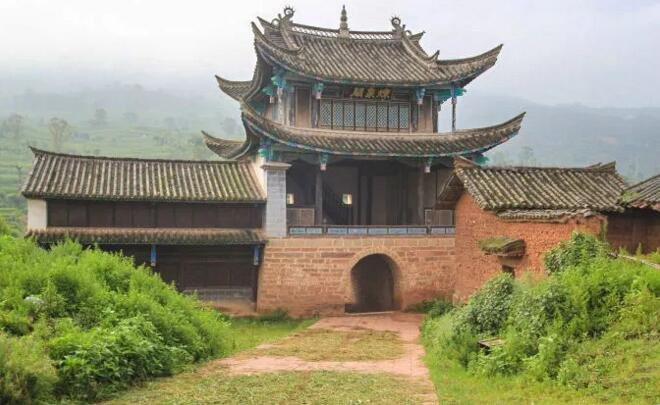
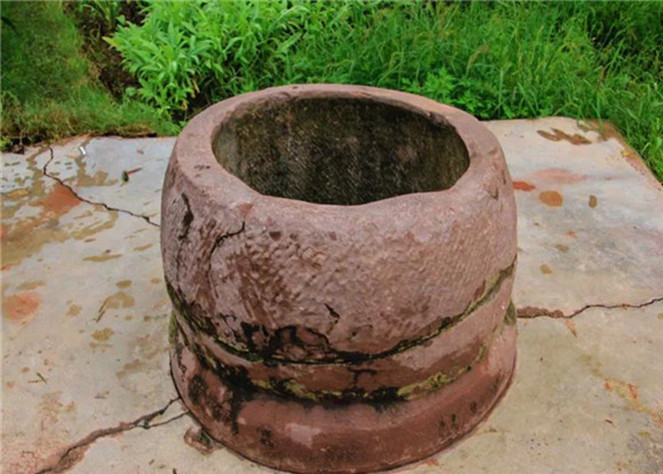
Why is Heijing Confucius Temple So Special
The Heijing Confucian Temple is located in the Longchuanjiang River Gorge(龙川江峡谷), 92 kilometers northwest of Lufeng County, Chuxiong Prefecture. It is nearly 200 kilometers away from Kunming and 75 kilometers away from Chuxiong. The Heijing Confucius Temple was built in the 45th year of Ming Wanli (1617). It was repeatedly destroyed by mudslides in the Qing Dynasty and was repeatedly rebuilt. The Confucius Temple is large in scale. There were 13 scholars (进士), which could show the prosperity of Heijing culture education.
Where is Heijing Confucius Temple
It is located in Heijing Town, Lufeng County, Chuxiong Yi Autonomous Prefecture.
How to Get There
- In Chuxiong Passenger Station, there are buses to Heijiang.
- It is very convenient to Heijing Station by train from Kunming Railway Station.
- After arriving in Lufeng County, car rental or self-driving is the recommended way to get to Heijing Confucius Temple.
Best Time to Go
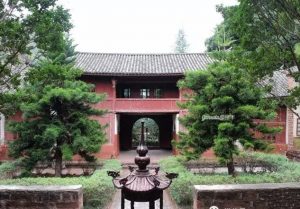
It is suitable to visit Heijing Confucius Temple at any time. Every season has its own beauty.
Nearby Attractions
Feilaisi Temple
Feilaisi Temple is located at the hillside. Because of the steep mountain, looking from the bottom of the mountain, the whole temple is like a big bird entwined in the mountain. It seems to be flying and it also seems to have just landed from the sky. Therefore, Feilaisi Temple got its name. Looking down from the temple, the Longchuanjiang River(龙川江) passes through the deep canyon, and the town’s buildings are dotted on both sides of the river.
The Grand Courtyard of Wu Family
The Grand Courtyard of Wu Family is a typical Ming and Qing architecture that has been preserved to now. The Grand Courtyard of Wu Family was built in the 16th year of Daoguang in Qing Dynasty. It was expended in the 7th year of Xianfeng in Qing Dynasty and was built along the mountain. It is a “王(Wang)-shape”, with a unique layout. It consists of four patios with 99 houses. It, with a building area of 10,000 square meters, is well-connected and is one of the rare ancient residential buildings in Yunnan.
Why is Langjing Ancient Village So Special
Langjing Village was known for salt production. It was even regarded as one of “the Nine Salt Wells of Ancient Yunnan” with a salt culture that can compete with Heijing Ancient Town. The religious culture there was enormously propelled by the salt industry. Kai’ning Temple, originally constructed in 725, is the best-known among those of Langjing to witness the co-existence of the Taoism, Buddhism and Confucianism. It’s been listed as an important historical and culture site of Lufeng County.
Langjing also has kept a distinctive native culture represented by the Dongjing Music (a kind of religious music). Most folk residences are designed in the style of the Central China; however, one also can find traditional houses of popular style in Yunnan. The highlighted architecture complexes include the Family Wen’s Garden, the Folk Residence of Li Jibo, the former residence of Zhang Jingchen who is a martyr, Dalong Shrine and the Old Pavilion of Family Jiang etc.
Where is Langjing Ancient Village
Langjing Village Committee is located in the northwest corner of Lufeng County, Yunnan Province. It is located at the junction of Lufeng and Mouding Counties. It is 86 kilometers away from Lufeng County and 20 kilometers away from Mouding County. It had the reputation of “the Largest Village” in Lufeng County in the early years of new China. In 2008, it was announced by the Yunnan Provincial People’s Government as a provincial-level historical and cultural village.
How to Get There
Langjing Ancient Village is 86 kilometers from Lufeng County. To some extent, it is inconvenient to get there. Car rental or self-driving is the best choice to get to Langjing Ancient Village.
History of Langjing Ancient Village
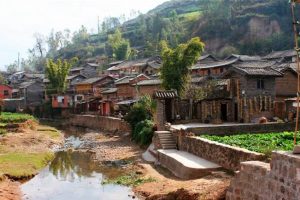
The Langjing Ancient Village was built in the foothill of the Tangdaishan Mountain(唐代山) and was produced in Nanzhao(A local regime in Ancient China). Langjing has a long history and profound cultural heritage. It is one of the “Nine Wells” in Yunnan. Langjing preserves the traditional features of the natural settlement of the thousand-year Salt Capital: the Quadrange Courtyard with five patios(四合五天井) of the civil structure. The most representative ones are mainly the Grand Courtyard of Wen Family (温家大院), the Folk House of Li Jibo (李继伯民居) in the middle street, the Former Residence of the revolutionary martyrs Zhang Jingchen(张经辰故居), and other traditional houses and ancient buildings have deeply confirmed the development of history and culture of Langjing. Langjing thrived due to salt. The development of the salt industry has brought about the development of salt culture.
Nearby Attractions
The Grand Courtyard of Wu Family
The Grand Courtyard of Wu Family is a typical Ming and Qing architecture that has been preserved to now. The Grand Courtyard of Wu Family was built in the 16th year of Daoguang in Qing Dynasty. It was expended in the 7th year of Xianfeng in Qing Dynasty and was built along the mountain. It is a “王(Wang)-shape”, with a unique layout. It consists of four patios with 99 houses. It, with a building area of 10,000 square meters, is well-connected and is one of the rare ancient residential buildings in Yunnan.
Feilaisi Temple
Feilaisi Temple is located at the hillside. Because of the steep mountain, looking from the bottom of the mountain, the whole temple is like a big bird entwined in the mountain. It seems to be flying and it also seems to have just landed from the sky. Therefore, Feilaisi Temple got its name. Looking down from the temple, the Longchuanjiang River(龙川江) passes through the deep canyon, and the town’s buildings are dotted on both sides of the river.
Heijing Confucius Temple
The Heijing Confucian Temple is located in the Longchuanjiang River Gorge(龙川江峡谷), Lufeng County, Chuxiong Prefecture. The Heijing Confucius Temple was built in the 45th year of Ming Wanli (1617). It was repeatedly destroyed by mudslides in the Qing Dynasty and was repeatedly rebuilt. The Confucius Temple is large in scale. There were 13 scholars (进士), which could show the prosperity of Heijing culture education.
Heijing Ancient Town
With traditional folk residences, archways, and religion architectures, Heijing Ancient Town is well conserved in a traditional style as others do in China. Among them, 27 have been listed as county-level cultural relics protection units, and are known as “the treasure house of historical relics – the living fossil of Ming and Qing Dynasties”.
Chinese Name:禄丰县广通文庙
English Name: Guangtong Confucius Temple in Lufeng County, Chuxiong
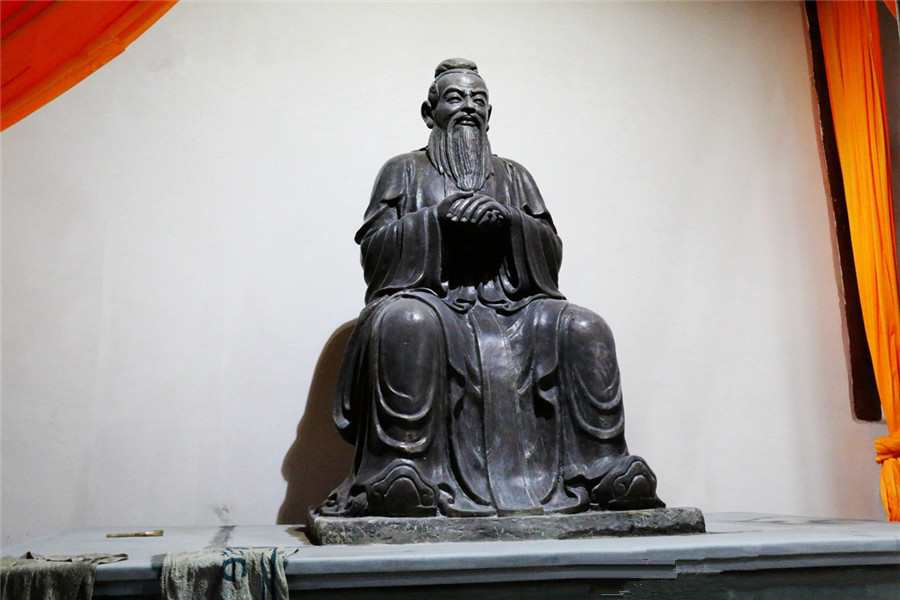
Pu Neng – Inheritor of “Yanglaogu Dance” in Lufeng County, Chuxiong
Pu Neng – Inheritor of “Yanglaogu Dance” in Lufeng County, Chuxiong 楚雄州禄丰县腰站乡“羊老鼓舞”传承人 – 普能 http://www.ynich.cn/view-ml-13111-2939.html...
Yang Shiming – Inheritor of Miao Musical Instrument -playing Skill in Lufeng County, Chuxoing
Yang Shiming – Inheritor of Miao Musical Instrument -playing Skill in Lufeng County, Chuxoing 楚雄州禄丰县腰站乡苗族乐器演奏技艺传承人 – 杨世明 http://www.ynich.cn/view-ml-13111-2834.html...
E Jiashou – Shadow Play Artist in Lufeng County, Chuxiong
E Jiashou – Shadow Play Artist in Lufeng County, Chuxiong 禄丰县川街乡皮影艺人 – 额家寿 http://www.ynich.cn/view-ml-13111-2696.html...
Xiao Guoqing – Inheritor of Stone Lion-carving Craft in Lufeng County, Chuxiong
Xiao Guoqing – Inheritor of Stone Lion-carving Craft in Lufeng County, Chuxiong 禄丰县黑井镇石狮雕刻传承人 – 肖国庆 http://www.ynich.cn/view-ml-13111-2614.html...
Feng Yulin – Master of Folk Buddha Sculpture in Lufeng County, Chuxiong
Feng Yulin – Master of Folk Buddha Sculpture in Lufeng County, Chuxiong 禄丰县民间佛像雕塑艺人 – 冯玉林 http://www.ynich.cn/view-ml-13111-2551.html...
Huashan Festival of Miao Ethnic Minority in Lufeng County, Chuxiong
Overview of Introducion Chinese Name: 禄丰县苗族花山节 English Name: Huashan Festival of Miao Ethnic Minority in Lufeng County, Chuxiong Location: Hongtushan Village of Qinfeng Town in Lufeng County/禄丰勤丰镇红土山村 The Flower...
ChuGuang Expressway from Chuxiong to Guangtong
ChuGuang Expressway from Chuxiong to Guangtong楚广高速公路(楚雄-禄丰县广通镇), Chuguang Expressway (楚广高速公路) is an important expressway in Yunnan Province, China, connecting Chuxiong City to Guangtong County. Here’s an overview of this expressway:...
The Grand Courtyard of Wu Family in Lufeng County, Chuxiong
Why is the Grand Courtyard of Wu Family So Special The Wu Family was the first large salt merchant in Heijing Ancient Town in the Qing Dynasty. In that...
Lianxiangguan Ancient Village in Lufeng County, Chuxiong
Why is Lianxiangguan Ancient Village So Special Lianxiangguan Ancient Village, known as the gathering place of salt merchants, has a long history, characterized by multi-culture. It thrived and declined...
Heijing Confucius Temple in Lufeng County, Chuxiong
Why is Heijing Confucius Temple So Special The Heijing Confucian Temple is located in the Longchuanjiang River Gorge(龙川江峡谷), 92 kilometers northwest of Lufeng County, Chuxiong Prefecture. It is nearly...
Langjing Ancient Village in Lufeng County, Chuxiong
Why is Langjing Ancient Village So Special Langjing Village was known for salt production. It was even regarded as one of “the Nine Salt Wells of Ancient Yunnan” with...
Guangtong Confucius Temple in Lufeng County, Chuxiong
Chinese Name:禄丰县广通文庙 English Name: Guangtong Confucius Temple in Lufeng County, Chuxiong...
Tips Before Travel
Bring copies of your passport
Don't assume you're restricted to the main hubs of Beijing and Shanghai, our tours can start from any city.
Register with your embassy
For your safety, please register with the Embassy.
Always have local cash
Exchange some local currency for your trip
Our Team
Customize a Trip
Start planning your tailor-made holiday to China by contacting one of our specialists. Once enquired, you’ll get a response within 0.5~23.5 hours.
